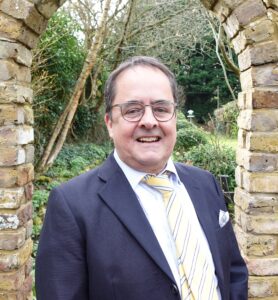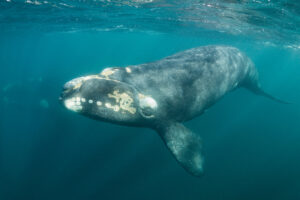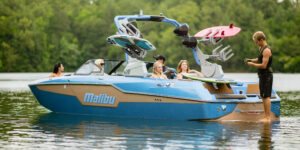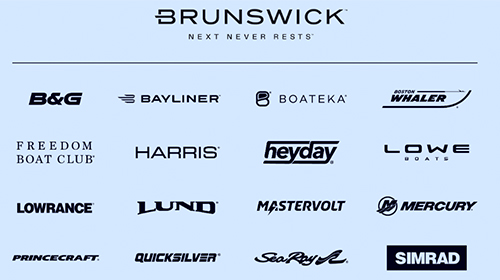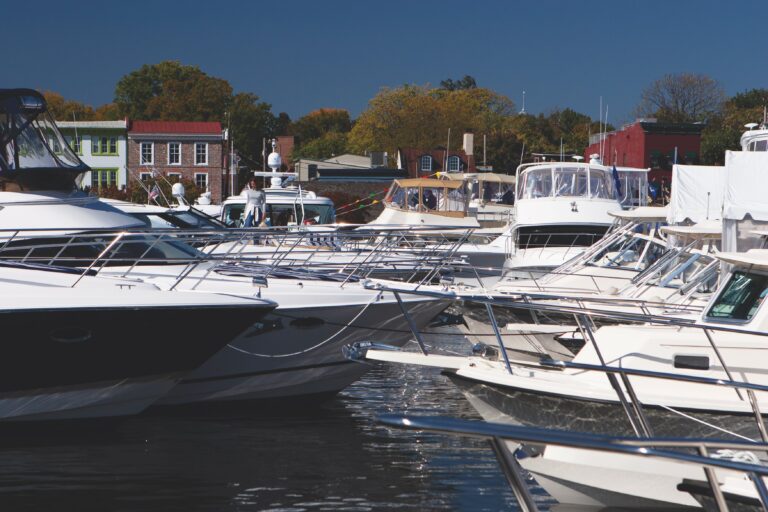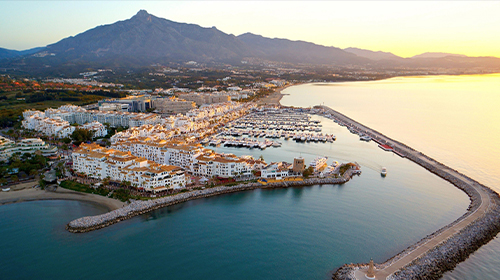
If you had no experience building fiberglass boats and wanted to start a company, where would you go? Michigan? Good idea. Florida? Another fine choice. Texas or North Carolina? Sure. Kansas? Eh, maybe not.
And would you pick a landlocked area several miles from any lake large enough for boating? Well, young, entrepreneurial Pack St. Clair, a Kansas native who grew up in the small town of Independence in the southeastern part of the state, did just that in 1968 at the age of 28. And his company, Cobalt Boats, now in Neodesha, Kan., (population 2,500) has grown into a very successful business that produces high-quality, award-winning boats.
I used to see St. Clair over the years at International Marine Trades Exhibit & Conference shows and NMMA conferences, and we have known each other for a long time. He was one of the first board members of the National Marine Manufacturers Association, along with such industry notables as Eddie Smith, Dave Parker and others. He also was the third chairman of the NMMA.
Independence has a population of 10,000 and is just 13 miles from Neodesha. Both towns are basically farm communities.
“My dad was a lumber salesman, calling on lumber dealers all over southeast Kansas, northeast Oklahoma and southwest Missouri,” St. Clair says. “He was still calling on dealers when he was 85 but then had to stop only because he was getting macular degeneration. He lived to be 97.”
St. Clair apparently inherited his father’s determination.

Learning about fiberglass
Boating has always been a St. Clair family passion. “As a kid,” St. Clair says, “I grew up boating. My dad bought a 14-foot Lone Star boat with a 35-hp Evinrude. We boated almost every lake in Kansas, and then we came down to boat on the Grand Lake of the Cherokees in Oklahoma. I wanted to put a new Evinrude V engine on the boat, but it wouldn’t handle it. So we got a used inboard boat to water-ski with.”
St. Clair went to the University of Kansas, where he was an end on the football team. “After graduation from college I worked in the lumber business for a couple of years, doing what my dad did — covering a territory in northeast Kansas and southeast Nebraska,” he says. “But I decided I really wanted to do something on my own and not work for someone else. So I left the lumber business.
“My next-door neighbor and I started a little company making giant slides 12 lanes wide and 40 feet high. People would sit on a burlap bag and slide down, but the slides turned out to be fairly dangerous if kids didn’t do it right. Our insurance company suggested we get out of that business and do something different. We had been making the fiberglass portion of the slides and contracting out the steel parts. And we also made a few other recreational things out of fiberglass. As a result, we gained some knowledge about making things out of fiberglass.”
When the insurance company said in 1967 that St. Clair and his partner needed to make something other than the slides, Pack said, “Well, we’ll just make boats.” And they did.
“We copied some boats.” St. Clair says. “Donzi was just getting into business and was making pretty snazzy boats, so we copied some of those. Then we had a boat designer design a 16- and 18-foot tri-hull for us. At that time these were our only boats that were of our design. Then we bought some tooling from a company in Dallas named Tem Craft that had gone out of business. They had a little 15-foot outboard bowrider, so we made a few of those.

“We had introduced our boats in 1968, and I had been traveling around the country trying to sell boats. Then I bought a Dun & Bradstreet service that provided me with a file card on every dealer they had listed in America. I put that in the front seat of my car and would take off on Monday, and I might show up at home again the next month. I traveled the whole country. I had a double-deck trailer with a couple of our boats on it that I pulled behind my car. I signed a few dealers, but I was really looking forward to going to the 1969 IMTEC because I had heard that is where dealers came to buy new lines.
“This was our first chance to see the whole industry. So we took our conglomeration of boats to the show in Chicago. The show was out at the Chicago stockyards, as this was the year that McCormick Place burned. So that is where we showed Cobalt Boats to the world, and nobody had heard of us for the most part.”
Laughing, he says, “To say that we were unsuccessful would be an understatement because we didn’t sell a single boat or sign a single dealer.”
The ‘dumbest’ name
IMTEC was an eye-opening experience for St. Clair. He saw a lot of large boat companies, such as Glastron, Sea Ray and even Outboard Marine Corp., which were making midpriced boats. He realized that to survive he had to go where they weren’t. He had to find a niche market.
“We came home from IMTEC and really scrapped this whole line of boats that we had copied, except for the two tri-hulls that were of our design,” St. Clair says. “So we started all over again. We had spent all our money and all that our partner had invested. And at this point my partner said, ‘I think I have had all the fun in the boat business that I want.’ So I bought him out and got an SBA loan and started over with a new partner, Dan Bramhall, who was at the time our fiberglass expert.”
St. Clair’s first boats were built in Chanute, Kan., and were named Kustom Craft. A couple of months before he went to his first IMTEC show, he tried to register that name. His lawyer said he couldn’t use the name because a company in the industry had already registered it.
So St. Clair called the printer who was just about to print his very first brochure and said he had to change the name. “How much time do I have to get a new name for the brochure?” St. Clair asked.
The printer said he needed the new name by noon that day to deliver the brochures in time for the show in Chicago. “I hung up the phone and didn’t think about a new name for more than about 5 or 10 minutes,” St. Clair says. “I called the printer back and told them the new name was going to be Cobalt.

“I had heard the name Cobalt because it was the promoter that is in the resins that we use that interacts with the catalyst that causes the resin to cure and get hard. I have liked the name, so that is what I chose. I went home that night and told my wife, Jill, that I had changed the name of the company. She said, ‘What is it?’ I told her it would be called Cobalt Marine. She said, ‘That is the dumbest name I have ever heard. That’s what they treat cancer with.’ I told her it was too late to change it. And it turned out to be a really good name. It has a nice ring to it and is easy to remember.”
Finding dealers
“That first IMTEC show was a pretty humbling experience,” St. Clair says. “We had some of our boats inside the hall and some outside. The boat we had outside was a 23-foot cuddy cabin. We were cleaning the boat in preparation for the show, and when I opened up our cuddy cabin, I saw that the headliner had fallen off during the trip to Chicago. We had used some shag carpet for the headliner and probably used the wrong kind of glue. I saw that I could push it back in place, and it would stay there for maybe five minutes. My wife, Jill, who was looking forward to shopping along Michigan Avenue in the Chicago Loop, actually spent the entire four days of the show sitting inside that boat. I stood outside the boat, and as I saw people coming over to look at it, I would bump the outside of the hull and Jill would put the headliner back up and it would stay for a few minutes.”
When they returned home, St. Clair and his team started their new concept.
“We moved from Chanute to Neodesha,” he says. “Neodesha gave us a building if we would move the plant there. So with our SBA loan we started building just two new boats. But we made sure that they were the very best there were, high-quality and the most expensive. We finished the first new top-of-the-line boat just before Christmas that year.”
St. Clair had heard about the San Francisco Boat Show at the Cow Palace. (I worked that show for OMC for several years, and it was excellent.) At that time, St. Clair says, Cobalt’s only California dealer was in Fullerton.
“I took our first new-generation, high-end, expensive and pretty boat out there,” St. Clair says. “I wanted to see if I could get a dealer there and hopefully get to display the boat in the Cow Palace show. I called on every dealer in San Francisco before the show, but couldn’t get one to take the line. Then I called on all the dealers in areas surrounding San Francisco but still didn’t get a dealer. Most of them said, ‘Son, I like your boat, but you are just too expensive.’ So at that point I was beginning to question my new concept of building top-end boats.”
Then St. Clair learned he couldn’t get his boat into the Cow Palace to display it at the show. Still determined, he made a deal with a Mobil station across the street from the arena. He parked his boat there, close to the sidewalk, and worked the 10-day show from that spot.
“I talked to lots of people as they went by and handed out a lot of brochures,” he says. “And I asked each of them to tell dealers as they walked the show that there was a really nice boat outside by the Mobil gas station. And a few dealers did come out and look at the boat toward the end of the show. Fortunately, one of them was Frank Warren of the San Ramon Boat Center. He became a dealer and has been with us now for 45 years.
“We have a lot of dealers that I signed up in those early years that are still with us. I think much of our success has been getting a lot of dealers over the years that weren’t always the biggest in their markets, but are better financed and overall more solid. Also, we have always picked dealers that offer good service. And we don’t jump around changing dealers. A lot of times, when things are tough, it is really tempting for boatbuilders to go down that road when the current dealer is stocked up with boats. But we don’t do that. Over the years, we have stuck with our dealers, and we have not tried to get into fishing boats, cheaper boats, sailboats, etc. We have stayed with our niche market. And our dealers continue to be one of our biggest assets.”
A proud Kansan
Since those early years, Cobalt has continued to grow and increase market share and has won numerous awards, including several from J.D. Power and Associates. Cobalt has 700 employees, and many are from the local farm communities.
“The other big asset we have is our employees,” St. Clair says. “We have several second and third generations working at Cobalt.”
St. Clair’s son Paxson joined the company in 1989 and became CEO in 2007. “Paxson is doing such a good job running the company now that I do my best to stay out of his hair,” St. Clair says with a laugh. “Sean Callan, my son-in-law, is president and runs production and engineering. He is also key in the organization.”
Says Paxson St. Clair: “I travel to a lot of boat shows around the country. Folks that I meet at shows think I am kidding when I tell them we build our boats in Kansas. We could not build our boats anywhere else because of the people who work at Cobalt. We don’t believe that their work ethic and the pride they have in doing the best job possible can be duplicated anywhere else in the world. We have second- and third-generation people working here at Cobalt. As we say on our website, ‘We never aimed to be the biggest boat company, just the best.’ ”
Innovation has continued at Cobalt with the successful introduction of the company’s first pontoon boat, the Marker One, at a dealer meeting in September.
“We recognize that the pontoon market has been growing and felt there would be a market for a Cobalt pontoon with yacht quality,” Paxson says. “Our Marker One pontoon boats feature a hull design that utilizes the finest grade of materials, higher-gauge aluminum, skilled craftsmanship in the construction and a unique grid system establishing the foundation. Our Marker One hulls are bolted through a structural stringer system, which seamlessly integrates the ‘wood-free’ fiberglass deck to the hulls themselves, a fiberglass liner with UL-approved diamond nonskid, non-slip surface. We have had an enthusiastic reaction to the Marker One from our dealers and consumers.”
Making Cobalt wine
Pack St. Clair’s entrepreneurial spirit did not stop with Cobalt Boats. He has always had a strong interest in wine and decided to create a Cobalt wine.
“I have been a wine enthusiast for a long time,” he says. “I got introduced to Napa Valley through some friends. Jill and I have always enjoyed going out there and enjoying the wine. One of the wines I have always liked was from a particular company up on Spring Mountain called Sherwin Family Vineyards. Steve Sherwin got to be a personal friend. I told Steve I would love to make a high-end cabernet sauvignon wine and call it Cobalt wine. After a few years, Steve called me one day and said, ‘There are some grapes that are available here on several acres adjoining our vineyard.’ So I made a deal and bought the grapes off that property, and Steve picks them and does the fermentation and aging. My only involvement is in the blending. Steve does the rest.
“We have gotten some great ratings for our Cobalt wine,” St. Clair adds. “Our first vintage was 2005. … Our wine bottles have a Cobalt logo on the front.”
St. Clair now makes his home in Lawrence Kan., where he graduated from the University of Kansas. He spends most of the year there and enjoys going to the university’s football and basketball games. In the summer he and his wife travel often to a home they have at Grand Lake of the Cherokees in northeastern Oklahoma near the Kansas and Missouri borders. This is the lake where his father often took the family boating as Pack was growing up. He drives to the plant about once a week.
“When I come to the plant each week, I like to spend all my time out in the plant,” he says. “I think my title today would be, ‘Keeper of the culture of Cobalt.’ ”
And the culture of Cobalt and of Cobalt Boats is unquestionably as good as you can get. n
Ben Sherwood, a 50-year veteran of the marine industry, was head of sales and marketing at Evinrude and Johnson for several years during his career at Outboard Marine Corp. After retiring from OMC, he was a marine trade magazine columnist for 18 years and a consultant in the industry. He wrote the book “How to Succeed in Marine Retailing.” He can be reached at [email protected].
This article originally appeared in the May 2015 issue.


